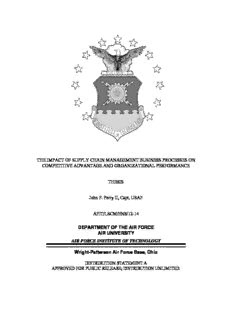
The Impact of Supply Chain Business Processes on Competitive Advantage and Organizational ... PDF
Preview The Impact of Supply Chain Business Processes on Competitive Advantage and Organizational ...
THE IMPACT OF SUPPLY CHAIN MANAGEMENT BUSINESS PROCESSES ON COMPETITIVE ADVANTAGE AND ORGANIZATIONAL PERFORMANCE THESIS John F. Perry II, Capt, USAF AFIT/LSCM/ENS/12-14 DEPARTMENT OF THE AIR FORCE AIR UNIVERSITY AIR FORCE INSTITUTE OF TECHNOLOGY Wright-Patterson Air Force Base, Ohio DISTRIBUTION STATEMENT A APPROVED FOR PUBLIC RELEASE; DISTRIBUTION UNLIMITED. The views expressed in this thesis are those of the author and do not reflect the official policy or position of the United States Air Force, Department of Defense, or the United States Government. AFIT/LSCM/ENS/12-14 THE IMPACT OF SUPPLY CHAIN MANAGEMENT BUSINESS PROCESSES ON COMPETITIVE ADVANTAGE AND ORGANIZATIONAL PERFORMANCE THESIS Presented to the Faculty Department of Operational Sciences Graduate School of Engineering and Management Air Force Institute of Technology Air University Air Education and Training Command In Partial Fulfillment of the Requirements for the Degree of Master of Science in Logistics and Supply Chain Management John F. Perry II, BS Captain, USAF March 2012 DISTRIBUTION STATEMENT A APPROVED FOR PUBLIC RELEASE; DISTRIBUTION UNLIMITED. AFIT/LSCM/ENS/12-14 THE IMPACT OF SUPPLY CHAIN MANAGEMENT BUSINESS PROCESSES ON COMPETITIVE ADVANTAGE AND ORGANIZATIONAL PERFORMANCE John F. Perry II, BS Captain, USAF Approved: ____________//signed//______________________ _15 Mar 2012_ William A. Cunningham III, PhD (Chairman) Date ____________//signed//______________________ _15 Mar 2012_ Sharon G. Heilmann, Lt Col, USAF, PhD (Member) Date ____________//signed//______________________ _15 Mar 2012_ Daniel D. Mattioda, Maj, USAF, PhD (Member) Date AFIT/LSCM/ENS/12-14 Abstract Organizational performance has routinely been viewed through a limited scope primarily focused on functions, practices, and resources directly controlled by the focal organization, but supply chain management (SCM) has broadened this scope to incorporate all organizations along the supply chain. This shifted the notion of competition from that of between individual organizations to between supply chains. Supply chain management is an ever growing field; multiple SCM frameworks exist today and are being further developed and defined. Successful firms must reside on the leading edge of management techniques, theories, and practices in order to stay competitive in an ever growing, more constrained, increasingly diverse, and rapidly changing global economy. Supply chain management is at the forefront of such management techniques, theories, and practices. Supply chains vary from firm to firm and from industry to industry. Firms have limited resources and a desire to know if the development and implementation of SCM within their firm is, in fact, going to equate to enhanced organizational performance and competitive advantage. This thesis conceptualized and measured three of the eight key business processes (customer relationship management (CRM), order fulfillment (OF), and returns management (RM)) across the supply chain according to The Global Supply Chain Forum framework. Do these key business processes lead to increased firm performance and a competitive advantage? This thesis developed a survey and collected data from private organizations and, through statistical analysis, measured the strategic development of the CRM, OF, and RM processes of organizations and their relationship to competitive advantage and organizational performance. The results of this thesis iv AFIT/LSCM/ENS/12-14 found each of the processes were positively related to competitive advantage and organizational performance. The results will serve as value to both academics and practitioners by expanding existing SCM literature and provide firms with a deeper understanding of how SCM business processes truly measure up. v AFIT/LSCM/ENS/12-14 This thesis is dedicated to my amazing wife, whose optimism, support, understanding, and love made this journey possible. This thesis is also dedicated to my son, who serves as a constant inspiration in my life and reminder of just how blessed my wife and I are. vi Acknowledgments I would first like to express my sincere appreciation to my faculty advisor, Dr. William Cunningham III, for his honesty, patience, and mentorship from the beginning of my AFIT career though the completion of this thesis. His expertise and charisma made this endeavor an experience I will always cherish. I would also like to thank my committee members, Lt Col Sharon Heilmann and Maj Dan Mattioda, for sharing their knowledge, insights, and recommendations that were critical to the completion of this thesis. I couldn’t have asked for a better committee; they were invaluable. I would also like to thank Lt Col Joseph Skipper for sharing his enthralling vision of supply chain management which served as the catalyst for this research. I am also extremely grateful for not only having Lt Col Sharon Heilmann on my committee but also as my academic advisor. She made this program an extraordinary experience I will always be grateful for. John F. Perry II vii Table of Contents Abstract ............................................................................................................................. iv Acknowledgments ........................................................................................................... vii Table of Contents ........................................................................................................... viii List of Tables .................................................................................................................... xi I. Introduction .................................................................................................................. 1 II. Literature Review ....................................................................................................... 5 Supply Chain Management ............................................................................................. 5 Customer Relationship Management ............................................................................ 10 Order Fulfillment ........................................................................................................... 20 Returns Management ..................................................................................................... 27 Competitive Advantage ................................................................................................. 36 Organizational Performance .......................................................................................... 37 Summary ....................................................................................................................... 38 III. Methodology ............................................................................................................ 40 Procedures ..................................................................................................................... 40 Participants .................................................................................................................... 41 Measures ........................................................................................................................ 47 Summary ....................................................................................................................... 58 IV. Results and Analysis ................................................................................................ 59 Data ............................................................................................................................... 59 Hypothesis One ............................................................................................................. 60 Hypothesis Two............................................................................................................. 60 Hypothesis Three ........................................................................................................... 61 Hypothesis Four ............................................................................................................ 61 Hypothesis Five ............................................................................................................. 61 Hypothesis Six............................................................................................................... 62 Summary ....................................................................................................................... 62 V. Discussion ................................................................................................................... 65 Limitations .................................................................................................................... 66 Future Research ............................................................................................................. 69 Conclusion ..................................................................................................................... 70 Appendix A. Survey ........................................................................................................ 72 viii Appendix B. Item Correlations ...................................................................................... 85 Appendix C. Storyboard ................................................................................................ 88 Bibliography .................................................................................................................... 89 Vita ................................................................................................................................... 95 ix
Description: